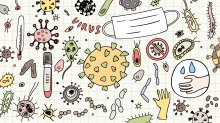Science Lessons That Tap Into Student Curiosity About COVID-19
Teaching about coronavirus can make learning more relevant while helping students cope with feelings of uncertainty and instability.
Your content has been saved!
Go to My Saved Content.Some students aren’t just wearing masks to class; they’re experimenting on them.
Inspired by the daily use of masks during the pandemic, fifth-grade students at New Albany Intermediate School in Ohio set out to measure the effectiveness of different mask types and brands by their ability to prevent droplet transmission. Using black lights, food coloring, and a range of mask brands, students learned how aerosol particles travel, how masks work to mitigate transmission, and how different types of masks offer varying levels of protection, says teacher Pete Barnes.
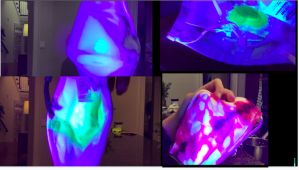
Barnes’s students aren’t the only ones using the pandemic as a teachable moment—educators all around the country have been developing lesson plans to help students make sense of the unprecedented time in history and take appropriate precautions to protect themselves, even as students increasingly return to in-person schooling.
“Kids think and talk about the pandemic all of the time, so it’s important they get accurate information based in science,” says Barnes. “When they research [the pandemic] on their own and perform experiments, they have deeper levels of understanding and ownership over topics that otherwise just seem scary and unpleasant.”
Though educators may be worried about inundating students with doom and gloom, weaving real-world context into lessons, especially during challenging times, can make students feel that their learning has more purpose and relevance. Additionally, having children explore their fears and unanswered questions can help them cope with feelings of uncertainty and instability, common during the pandemic, say psychologists. Just be careful not to dismiss or minimize their concerns outright, and give students the opportunity to opt out or choose other activities if learning about the pandemic is too much to bear.
“It’s not helpful to remove all mention of current events from the classroom, and... it’s also not helpful to spend all day, every day, engaging in heavy conversations,” writes Alex Shevrin Venet, a trauma-informed expert. “The key here is balance.”
The Science of Protecting Yourself
Mask testing: Before they launched into their experiments, Barnes says, students had their own opinions—and preferences—on masks but were curious about testing out what they’d heard from adults outside of class.
In one experiment, students put green food coloring in their mouths, exercised for two minutes while wearing masks, and then used a black light to spot how much food coloring transferred to the outside of their masks. This helped students understand how germs penetrate their masks and determine which cloth mask would be best for exercising.
Another group of students tested three different mask types (N95, surgical, and cloth masks) by spraying colored water on the inside of the mask. They found that the N95 mask was most effective at stopping the water from going to the outside; surgical masks ranked second, and cloth masks were third. In doing so, students “fulfilled standards related to scientific inquiry, data collection, forming hypotheses, and drawing conclusions,” says Barnes.
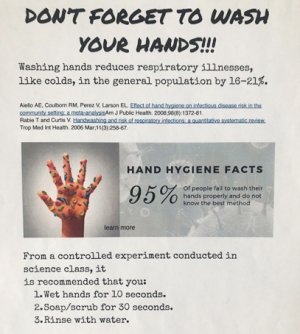
Wash your hands: Stephanie Kearney’s students happened to be knee-deep in a science unit on microbes when the pandemic hit last year. To investigate infectious diseases, they attempted to diagnose a fictitious patient based on symptoms, says Kearney, who teaches seventh-grade students at Penn Alexander School in Philadelphia, Pennsylvania. Her students added COVID-19 as a potential cause of illness but ultimately determined that their patient had the common cold.
The project ended with students collecting data from scientific journals about the effect of hand hygiene on infectious disease risk, which they then used to determine the best method of handwashing. They shared what they learned in public service announcements (PSAs), which were posted around the school buildings. While the activity was originally planned for in-person instruction, students were still able to collaborate with their peers from a distance using digital tools like Jamboard, says Kearney.
Social distancing: As states reopen schools for in-person learning, teachers and students are gearing up for ways to safely return to the classroom. Second-grade teacher Melissa Collins of John P. Freeman Optional School in Memphis, Tennessee, says her students are working on a project called “Flatten the Curve.” After hearing a doctor present information on social distancing, students were tasked with thinking about ways to socialize with their friends safely, like using FaceTime or having air hugs. To show what they learned, they could make a skit, write a poem, or create a prototype.
Nanobots and Gizmos
Attacking the virus: At Coppell Middle School East in Texas, science teacher Jodie Deinhammer developed an engineering activity called “COVID Nanobots,” where her seventh-grade students designed a nanobot, or a microscopic robot, that mimicked a human cell but was able to attack and kill the coronavirus. Students familiarized themselves with COVID facts, considered which cell organelles their virus-buster would use to imitate real cell behavior, and sketched out a rough prototype of the nanobot on their iPads. In developing their nanobot concept, students answered questions such as “How does the nanobot get energy?” and “Is the nanobot cell more similar to a plant, an animal, or a bacteria cell?”
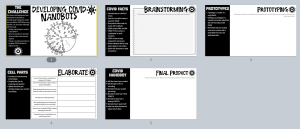
How viruses spread: Jennifer Sweaks, a biology teacher at Allen High School in Texas, developed a multitiered lesson plan that reflected the progression of the pandemic. In the early weeks of the module, Sweaks’s students learned about epidemiology by doing research on the Centers for Disease Control and Prevention (CDC) and World Health Organization (WHO) websites.
In addition, they completed an interactive simulation called Gizmo (this lesson was free, with an account), focused on disease spread, and explored the transmission and treatment of HIV using research studies by the National Institute of Allergy and Infectious Diseases. To incorporate multimedia, Sweaks created lesson plans on TEDEd that showcased how viruses jump from animals to humans and how funding for virus monitoring programs—and the lack thereof—have impacted global efforts on curbing emerging diseases.
Putting it into perspective: In a module designed by Heather Milo, instructional specialist with the Institute for School Partnership at Washington University in St. Louis, and middle school science teacher Mary Bueckendorf of Hawthorn Leadership School for Girls in St. Louis, Missouri, students shared their own experiences with the COVID-19 pandemic and the questions they had about the virus. Students then embarked on a quest to find out about pandemics of the past, how the coronavirus spreads, and how the spread can be contained. They also critically evaluated media and public health information about the virus and used social media to amplify preventive measures to reduce transmission.
The lesson has since been shared with local teachers in the entire St. Louis region, and one district even added a virtual field trip to the module where students watched a COVID test being performed in real life while having the opportunity to pose questions to the chief operating officer of the St. Louis County Department of Health.
The Antidote to Misinformation
Combating misinformation: Stephanie Toro, a former teacher and now an assistant professor at the Universidad de los Andes in Bogotá, Colombia, has been teaching her students how to read and interpret data with a focus on the misinterpretation of science around COVID-19. Her students analyzed both popular articles and more scientific articles from magazines like Scientific American, using a guide that helped them determine how scientific the articles were.
Toro asked students to examine the data presented in the articles separately, arrive at a conclusion themselves, and then compare with the narrative in the article. Having designed this lesson years ago, Toro has modified the selection of articles to make it appropriate for middle school and high school, and to fit whatever topic is timely—in this case, COVID-19.
Effective vs. ineffective treatment: In later modules of Sweaks’s multilesson plan, students explored the research on hydroxychloroquine, a medicine used to treat malaria and autoimmune disorders, which was briefly touted as a possible drug to prevent and treat COVID-19. Students read the results of controlled studies on the medicine in a TEDEd that Sweaks created that included a video about a couple who drank fish tank cleaner, believing it could prevent the coronavirus. To round out the module, Sweaks included a lesson on ecology that emphasized how protecting wildlife habitats could help prevent the next pandemic.
Vaccines and the future: Biology teacher Oshen Wallin teamed up with her coworker Leslie Schoof at Madison High School in Marshall, North Carolina, to help students conduct research about COVID-19 based on the questions they had about the virus, including what the vaccine trials entail and how the different COVID-19 vaccines work. Through the project, they learned how to conduct proper research and identify and analyze reputable, unbiased sources.
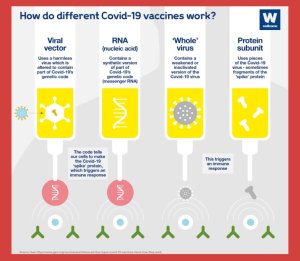
Working with school nurses and the county library system, students at Madison High then summarized what they learned and developed a website to display their information. The students even went on to present their research to the school superintendent, and they have plans to present to the school’s administration.
“The goal is to distribute their research to the community and beyond in hopes to inform others about COVID-19 with reputable information and possibly help save lives,” adds Wallin.
